C.A. Gray's Blog, page 5
February 14, 2025
Miracles, C.S. Lewis

I didn’t know there were any C.S. Lewis books I’d never read before, but apparently there was–at least one I’d never read completely! I think when I tried to read this one in the past, I was bored by the topic, because I was already convinced that miracles existed and so contemplating the topic seemed a pointless exercise. But this time, what really arrested me was that Lewis wasn’t so much arguing for miracles, as he was dismantling the illogic of the opposite point of view. Lewis I think must have been one of the clearest thinkers ever to live and also write (I don’t know about those who never wrote anything down). I marvel when I read his work, wondering whether talking to him was like reading his work. Did he just come up with the perfect, pithy words in dialogue, too, able to reduce all complex concepts into a single, all-encapsulating sentence? Or did he have to work at it, and try on multiple metaphors for size until he found just the right one to commit to pen and ink?
At any rate, because this book starts with first principles of what is knowable about the world at large, and worldviews and how they color our perceptions, it was particularly relevant for what I happen to be writing myself at the moment.
My rating: ****
Language: none
Sexual content: none
Violence: none
Political content: none
The post Miracles, C.S. Lewis appeared first on C.A. Gray.
February 6, 2025
The Duke’s Treason: The Poisoner of Kingfountain, Book 4, Jeff Wheeler
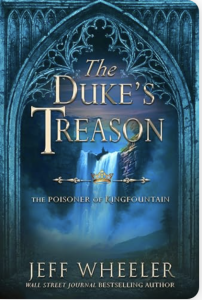
I loved the Kingfountain series, though it’s been awhile since I read it so I didn’t remember a lot of the specifics. While that story followed Owen primarily, this story opens with his birth (which started out as a stillbirth, and I thought that was awfully grim… but stick with it, he comes back. Which, had I known this would be Owen, I’d have also guessed.) It’s the poisoner from the original series, Ankarette, who is also a midwife, who speaks the words of power and brings him back. This is Ankarette’s story, or at least some of it.
When the story opens, she has already been poisoned herself by her arch villain, Lord Hux, a rival poisoner who hopes to bring her over to the “dark side.” Ankarette is fountain-blessed (which essentially means she’s been given supernatural giftings) and the Fountain (God, in this world) speaks to her when needed. Like all of Wheeler’s heroes, she is uncorruptable–but she is sorely tempted. I felt very sorry for her, that she was locked into service to the royal family she loves, but that meant she was unable to have a family of her own, even as she attends the births of all of these babies when her own womb was shriveled by the poison. A man who proposed to her twice and whom she was forced to reject comes back into her life, and they have to work together to unravel a plot against the royal family.
Since this is a prequel, I already knew how Ankarette’s story ends, and therefore how this one could not end. But still I hoped, because she is such a sympathetic character. I don’t know if I’d exactly say it ends sad though… it’s more bittersweet. Wheeler usually manages to pull that off, by zooming out and showing the bigger (spiritual) perspective, within the context of the fantasy world, to make all of the seemingly negative events seem temporary and potentially even redemptive. That’s one of the things I love about his books so much.
My rating: ****
Language: none
Sexual content: none
Violence: fantasy only
Political content: none
The post The Duke’s Treason: The Poisoner of Kingfountain, Book 4, Jeff Wheeler appeared first on C.A. Gray.
January 31, 2025
Tress of the Emerald Sea, Brandon Sanderson
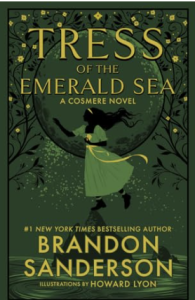
This was such a cute read! In the tongue-in-cheek narrative voice, it reminded me a little of “The Princess Bride.” The narrator is a character in the story, too, so periodically he will start to go off on some philosophical rambling or moralizing, which made the story much more unique and engaging.
That aside, the story follows Tress of course, and the narrator goes out of his way to tell us that she is not at all similar to typical storybook heroines in the sense that she had no interest in adventure whatsoever. She is very practical, content with simple pleasures (like collecting tea cups), and she is of low birth. She falls in love with Charlie, the gardener, or so she thinks… and he has a problem with verbal diarrhea, never quite knowing when to stop talking or when his stories have bored his listeners. But Tress loves him, and finds his stories endearing. He falls for her too, of course… and then eventually she realizes that he is royalty, and his father insists on marrying him off to a princess.
I expected at this point that romance would be a big part of the story, but really this was just the setup. Charlie (hilariously) writes Tress about how he’s purposely put off, offended, or disgusted every potential match, holding out for her… but then he goes missing. Tress hears about the sorcerer who holds him captive, in the midst of several notoriously treacherous seas, and decides that despite the fact that she has no experience as a sailor or an adventurer of any kind, despite the fact that all she’s ever wanted is to stay home and never have any adventures whatsoever, she sets off to try to rescue him.
This might seem like a reverse damsel in distress story (with a pathetic male incapable of doing anything except be rescued by a badass female), but it really isn’t. Tress succeeds by dumb luck and goodness much of the time, and by winning the allegiance of those around her. Charlie doesn’t at all turn out to be what you expect, either. The fantastical obstacles are quite creative–I’ve never read anything like it before. And the ending is satisfying. I only knocked off the last half star because it seemed to lack a certain indescribable something that hooked me and kept me reading… not sure what it is exactly, but while I enjoyed the story, it wasn’t like I couldn’t put it down. I suppose that might have been a byproduct of the narrative distance: since the narrator himself was such a character, I was maybe less engaged with Tress herself than I might have been otherwise.
My rating: ****1/2
Language: none that I recall
Violence: fantasy only
Sexual content: none
Political content: none
The post Tress of the Emerald Sea, Brandon Sanderson appeared first on C.A. Gray.
January 23, 2025
This This, Not That, Josh Axe
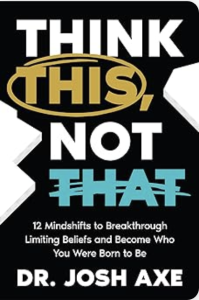
I’ve read so many self-help books over the years that I rarely bother with them anymore, since they mostly seem to say the same things I’ve heard over and over again. I picked this one up only because it was on an Audible daily deal, and I’m familiar with the author for his work in natural health–and also because the book is categorized under faith and religion, which I found intriguing.
The first few chapters were (as the title suggests) just about entertaining positive and affirming thoughts rather than negative ones. Nothing earth-shattering there. But I became more intrigued with chapters that emphasized not just positive affirmations, but reevaluating life goals, and making sure that you’re not merely a high achiever, but you’re becoming a better person, since ultimately that matters far more. (There were a lot of missed opportunities for quoting scriptures here, but I think the book is meant to appeal to a wider audience, which might be why it didn’t go there.) I was especially intrigued when the author linked this concept to Joseph Campbell’s “The Hero’s Journey,” encouraging readers to be inspired by and to view their lives through the lens of some of their favorite stories. I’ve always found the concepts from “The Hero with a Thousand Faces” to be fascinating.
One thing I will say about this book, that might be specific to me (but then again, since self-proclaimed “achievers” are the ones who will likely read a book like this, maybe not): the author tells a lot of personal stories as well as stories of famous people in his own inner circle, all of which are spectacular, glowing, and larger-than-life. They were things like building this multimillion dollar business empire before the age of 40 (and then moving on to the next big adventure because, conquered that mountain), creating a mastermind group with that superstar, going on those fabulous vacations, spending time with their perfect families, building their dream houses, etc. I understood the reason: he’s trying to illustrate the power of these principles in action, but rather than being relatable and inspirational, it was too much. It made me feel like, “why bother? I’m never going to be anywhere near that league.” I felt this way until I read the last chapter, when the author revealed his own major health challenge, and how he used some of the principles in this book to overcome it. I felt like that humanized him, and I wish he’d included that or something like it earlier in the story.
My rating: ****
Language: none
Sexual content: none
Violence: none
Political content: none
The post This This, Not That, Josh Axe appeared first on C.A. Gray.
January 17, 2025
Upgrade
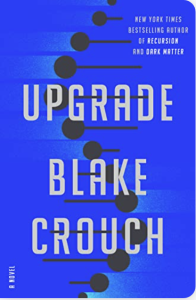
I picked up this book as it was recommended by Andy Weir (one of my favorite authors) – so I was expecting something relatively similar to his writing style. It wasn’t exactly similar in terms of narrative voice, but I can definitely see why he would like it, as this is a very smart and scientifically grounded thriller.
The story follows Logan in a near-future world, just after a major catastrophe in the field of genetics inadvertently unleashed a global famine (incidentally by Logan’s late mother, Miriam Ramsey). Logan works in a federal group to investigate and contain what appear to be potential genetic enhancements, to contain them, trying to get away from his legacy… until he himself ends up the victim of a massive genetic upgrade, which he later learns was engineered by his mother. The background of the story is that (for various politically correct reasons), humanity is about to die out… and Logan’s mother believed that only exceedingly smart (and fast, and capable) humans could outsmart the fate that awaits them. But he, and he later discovers his sister, are the first test subjects. The description of Logan’s experiences as an upgraded human, and how he deduces what has happened to him, is probably the best and most fascinating part of the book.
Logan’s sister and he end up at idealogical odds–working against one another, but each in what they believe is the best interest of humanity. The ending essentially is what it must be, so there weren’t a lot of surprises once the story gets going, but of course there is a lot of reflection on what it means to be human, and what traits are truly most important.
My rating: ****1/2
Language: lots, though it could have been worse
Sexual content: I don’t remember any but it’s the sort of book in which it was probably there…
Violence: present, but while this wasn’t excessive, some of the gory aftermath really was
Political content: moderate, I’d say. It was a driving premise.
January 10, 2025
The Invisible College
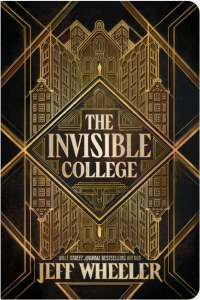
Another great read by Jeff Wheeler! I always know what I’m getting with his books – the very specific, rather formal narrative voice (no slang here), main characters with a strong sense of moral integrity and a sense that anything is possible if they put their minds to it, and a healthy and imaginative dose of magic, in various forms.
This one was unique (as the foreword says) because McKenna, one of the two main characters, is deaf, though that really doesn’t change the way she’s portrayed almost at all. It just shapes her story. She lives in a world where you have to sing magical spells for them to act, but because she’s deaf, she can’t sing. In this world, deafness also typically relegates the disabled to the outer edges of society, but McKenna is exceptionally bright and determined, and she’s from a wealthy family, so she manages to learn to read lips and speak so well that most can’t even tell that she’s deaf, so at least this doesn’t apply. But she dreams of practicing magic, and joining the “Invisible College” of practitioners (so called because finding the entrance to the college is the first magical test). To this end, her father hires a tutor for her, Robinson Hawksley.
He’s poor, rarely eats enough, and so he looks far older than his 27 years, but he falls in love with McKenna quickly. Her family disapproves of the match, but he boldly pursues her and declares himself early enough that he wins her over.
Meanwhile, an ancient magical race called the Aesir exist in the coldest regions of the earth, where they hibernate for up to a century at a time. Every time they awaken, they wreak havoc on humanity, and attempt to destroy them. Military forces remain ever vigilant for their reawakening, though generations of humans come and go without engaging in conflict. But now, the Aesir are awakening. Professor Hawksley has an idea for an invention that may just tip the balance of power in the humans’ favor, and McKenna’s father is his benefactor–but he has to convince those in a position of power to believe him, rather than write him off as essentially an Aesir “shell” himself.
It’s very creative and an intricate plot, and part one of a series.
My rating: ****1/2
Language: none
Sexual content: none
Violence: fantasy only
Political content: none
The post The Invisible College appeared first on C.A. Gray.
January 3, 2025
Instant Karma

I last tried to read this four years ago, and gave up on it as I’d deemed it to be woke. I decided to give this book another try, though, as I’d always really enjoyed Marissa Meyer books in the past… but also because I read the second book in this “series,” (not really a series, more like standalone novels with characters in common) called “With a Little Luck.” It was very cute, and not woke at all that I recall, so I thought maybe I misjudged this one? As it turns out, I did.
The story follows Prudence, an uber-type A teen, and Quint, her (apparently) lazy, laid-back lab partner whom she initially despises. (Prudence’s twin brother is Jude, the main character in the second book.) At first Pru isn’t terribly likable, honestly, but that’s just a setup for a character arc. She and Quint get a low grade for their shared project (to do with eco conservation), which ruins Pru’s GPA, but (because Pru is horrible to him), Quint refuses to redo the project with her. Pru determines that she’ll do it on her own, and when she reads the report Quint wrote (she hadn’t even bothered to do that before), she learns of an animal rescue center in Fortuna Beach that needs volunteers. She decides to volunteer there in order to gain experience that will make it into her report… only to discover that not only does Quint himself work there, the rescue center is actually run by his mom.
Meanwhile, through a magical set of events in which you just have to suspend your disbelief, Pru acquires a micro-power: that of harnessing “the universe” to exact “instant karma” upon wrongdoers of various types. Pru seems like the worst possible choice for such a power, since she’s already so judgmental–but as time goes on, it becomes clear that at least in some cases, the universe doesn’t cooperate with her judgments, and sometimes rewards those whom she deems worthy of punishment. As the story goes on, and Pru’s character arc progresses, though, she learns that this is usually because there was more going on than she was aware of, and sometimes the people she thought were deserving of punishment, weren’t.
Of course it’s also a slow burn romance, as Pru learns how badly she misjudged Quint. Quint really didn’t misjudge Pru, but he’s a forgiving sort of guy when she comes around in the end… until a misunderstanding nearly wrecks them just as they get started. In general, I despise misunderstandings as a plot device (they make me so anxious), so I skipped several segments of those chapters, but I still got the rest of the story in full. And it was cute and enjoyable.
My rating: ****
Language: none
Sexual content: none
Violence: none
Political content: minor
The post Instant Karma appeared first on C.A. Gray.
December 27, 2024
Psalm 91

I first discovered this book over a decade ago and devoured it then. Recently, Peggy Joyce Ruth messages have been popping up on my YouTube feed, so I decided to revisit it. What a gem it is, and she is! I’ve learned so much from her, and been inspired by her stories (and her late husband Jack’s stories) of standing and believing God in faith against impossible odds. She interweaves these personal testimonies throughout the book, as she expounds and meditates (in print) upon what all is encompassed in the Psalm 91 comprehensive promise of protection. I’m inspired to write out my own meditation of the psalm, and pray it regularly over my family and friends, too.
My rating: *****
Language: none
Sexual content: none
Political content: none
Woke content: none
Unbroken

Wow.
I had heard about this and it was on my TBR list for a long time… I even felt like I recognized snippets of the story, and wonder if I’d tried to read it once before and given up. If I did, I imagine it was because at about the halfway point, the story became so incredibly grim. I had to skip a few chapters that I just couldn’t handle reading… but the end made it SO worth it.
Louie Zamporini was immediately painted as a compelling character, which is rare for a biography. Hillenbrand captured his hellion days as a youth, where every rule to him seemed made to be broken (I felt very sorry for his mother at that point!) But knowing at least the synopsis of the rest of the story, it was clear that this was a critical part of what made him resilient enough to withstand what was to come. He eventually channeled his determination into running, and was on track to be perhaps the greatest runner the world had ever seen. My heart broke for him when the Olympics on which he’d pinned all his hopes was cancelled due to WWII. And then he was drafted.
When his plane went down in the Pacific, the story really picked up (and this was the part I felt like I remembered). Three survivors on a raft for 40+ days with no food or water, and sharks circling… it’s horrific, but this was the first (and only) time until the end that spirituality really came into play. Louie was not a Christian yet, but one of his raft-mates, Phil, was, and eventually Louie found himself crying out to God in prayer. Miraculous answers to prayer sustained them from one catastrophe after another, though it didn’t end the ordeal for them. One of the raft-mates died, and it was clear from the beginning which one it would be, since the author made it clear that Mack had no hope from the beginning, while Pete and Louie did.
But then when they landed on an island, it turned out to be occupied by the Japanese. This part of the story felt interminable, filled with some of the most horrific and brutal depictions of man’s inhumanity to man that I’ve ever read. That’s when I skipped some chapters–which I felt almost guilty about (after all, this really happened to someone), but I felt like I got the gist. Perhaps a quarter of the very long book took place in one POW camp after another, until the war finally ended.
Then Louie attempted to adjust to civilian life, and got married, but suffered from severe PTSD, alcoholism, bitterness, and despair. In this section of the book, I kept wondering, but the title is ‘unbroken,’ and this sure sounds like he was broken… and he was, until he found Jesus at a Billy Graham event. I really didn’t see that coming. It was such a complete 180. I won’t ruin the end of the book for you, but it made me cry, it was so beautiful. Highly, highly recommend.
My rating: *****
Language: none
Violence: severe. Horrific. But it happened, so, what are you gonna do.
Sexual content: this is weirdly kind of mixed in with the violence, but it’s not rape, just sadism.
Political content: historical only
Icon and Inferno
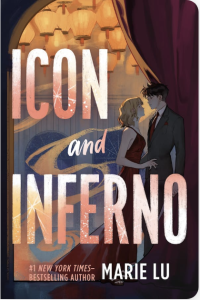
Marie Lu’s style keeps the pace moving, and the tension high. I usually enjoy her books, and this was no exception.
I suppose it wouldn’t be totally necessary to have read the first book in the series to follow this one, but it helps. Here, Winter Young, the world’s biggest pop star, again teams up with Sydney, a secret agent with a private firm. They hooked up briefly in the last book, and neither could stop thinking about the other, but they couldn’t imagine another scenario in which it would make sense to use a pop star as a secret agent. This time they need him to get Sydney in to a particular arena where he’ll be doing a show, and Sydney can pose as his bodyguard. She’s going in to try to rescue a fellow agent, who also happens to be an old flame of hers.
Of course, nothing is as it seems, and soon the whole thing blows up into an international scandal involving assassinations and double-crosses. Along the way, Sydney and Winter, who both have their own reasons for keeping the other at a distance, are forced to confront their feelings for each other.
It’s a fast read. Not totally clean, but could be a lot worse.
My rating: ****
The post Icon and Inferno appeared first on C.A. Gray.



